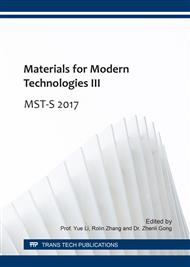[1]
S. Iijima, Helical microtubules of graphitic carbon, Nature 345 (1991) 56.
Google Scholar
[2]
J.Y. Zhou, M. Zhou, Z.Y. Chen, Z.X. Zhang, C.C. Chen, R.S. Li, X.P. Gao, E.Q., SiC nanotubes arrays fabricated by sputtering using electrospun PVP nanofiber as templates, Surf. Coat. Technol. 203(2009) 3219-3223.
DOI: 10.1016/j.surfcoat.2009.03.055
Google Scholar
[3]
Z.F. Xie, D.L. Tao, J.Q. Wang, Synthesis of silicon carbide nanotubes by chemical vapor deposition, J. Nanosci. Nanotechnol. 7 (2007) 645 -652.
DOI: 10.1166/jnn.2007.142
Google Scholar
[4]
L.Z. Pei, Y.H. Tang, Y.W. Chen, C. Guo, X.X. Li, Y. Yuan, Y. Zhang, Preparation of silicon carbide nanotubes by hydrothermal method, J. Appl. Phys. 99 (2006) 114306.
Google Scholar
[5]
G. Cubiotti, Y. Kucherenko, A. Yaresko, A. Perlov, and V. Antonov, The effect of the atomic relaxation around defects on the electronic structure and optical properties of beta-SiC, J. Phys.: Condens. Matter 11 (1999), 2265.
DOI: 10.1088/0953-8984/11/10/013
Google Scholar
[6]
G. Cubiotti, Y. Kucherenko, A. Yaresko, A. Perlov, and V. Antonov, Electronic states and optical properties of beta-SiC containing paired antisite defects, J. Electron Spectrosc. Relat. Phenom. 88(1998), 957.
DOI: 10.1016/s0368-2048(97)00186-2
Google Scholar
[7]
R. Aavikko, K. Saarinen, F. Tuomisto, B. Magnusson, N. T. Son, and E. Janzen, Clustering of vacancy defects in high-purity semi-insulating SiC, Phys. Rev. B 75 (2007), 8.
DOI: 10.1103/physrevb.75.085208
Google Scholar
[8]
R. Moradian, S. Azadi, and S. V. Farahani, Structure and electronic properties of native and defected gallium nitride nanotubes, Physics Letters A 372 (2008) 6935-6939.
DOI: 10.1016/j.physleta.2008.09.044
Google Scholar
[9]
D. Orlikowski, M. B. Nardelli, J. Bernholc and C. Roland, Theoretical STM signatures and transport properties of native defects in carbon nanotubes, Physical Review B 61(2000)14194-14203.
DOI: 10.1103/physrevb.61.14194
Google Scholar
[10]
R.J. Baierle, P. Piquini, L.P. Neves, R.H. Miwa, Ab initio study of native defects in SiC nanotubes, Phys. Rev. B 74 (2006) 155425.
DOI: 10.1103/physrevb.74.155425
Google Scholar
[11]
E. C. Anota,G. H. Cocoletzi, Influence of point defects on the structural and electronic properties of SiC nanotubes, Central European Journal of Chemistry 12 (2014), 53.
DOI: 10.2478/s11532-013-0357-6
Google Scholar
[12]
R.J. Baierle, R.H. Miwa, Hydrogen interaction with native defects in SiC nanotubes, Phys. Rev. B 76 (2007) 205410.
Google Scholar
[13]
R. L. Liang, Y. Zhang, J. M. Zhang, and V. Ji, Adsorption of oxygen atom on the pristine and antisite defected SiC nanotubes, Physica B 405 (2010), 2673.
DOI: 10.1016/j.physb.2010.03.053
Google Scholar
[14]
M. Khodadad, S. M. Baizaee, M. Yuonesi, and H. Kahnouji, First-principles study of structural and electronic properties of lithium doped SiC nanotubes, Physica E 59(2014), 139.
DOI: 10.1016/j.physe.2014.01.015
Google Scholar
[15]
J. Dai, D. Chen, and Q. Li, First-principle study on the X (X=N, P, As, Sb) doped (9, 0) single -walled SiC nanotubes, Physica B 447(2014), 56.
DOI: 10.1016/j.physb.2014.04.065
Google Scholar
[16]
J. Song, H. Liu, Y. Guo and K. Zhu, Electronic structures of Stone-Wales defective chiral (6, 2) silicon carbide nanotubes: First-principles calculations, Physica E 74 (2015) 198-203.
DOI: 10.1016/j.physe.2015.06.013
Google Scholar
[17]
B. Delley, An All-Electron Numerical Method for Solving the Local Density Functional for Polyatomic Molecules, J. Chem. Phys. 92 (1990) 508.
DOI: 10.1063/1.458452
Google Scholar
[18]
J.P. Perdew, K. Burke, M. Ernzerhof, Generalized Gradient Approximation Made Simple, Phys. Rev. Lett. 77 (1996) 3865.
DOI: 10.1103/physrevlett.77.3865
Google Scholar
[19]
H.J. Monkhorst, J.D. Pack, Special points for Brillonin-zone integrations, Phys. Rev. B, Solid State 16 (1977) 1746.
Google Scholar
[20]
M. Menon, E. Richter, A. Mavrandonakis, G. Froudakis, A.N. Andriotis, Structure and stability of SiC nanotubes, Phys. Rev. B 69 (2004) 115322.
DOI: 10.1103/physrevb.69.115322
Google Scholar
[21]
M. G. Mashapa, N. Chetty, and S. S. Ray, Ab Initio Studies of Vacancies in (8, 0) and (8, 8) Single-Walled Carbon and Boron Nitride Nanotubes, Journal of Nanoscience and Nanotechnology 12 (2012) 7030.
DOI: 10.1166/jnn.2012.6487
Google Scholar
[22]
P. Piquini, R. J. Baierle, T. M. Schmidt, and A. Fazzio, Formation energy of native defects in BN nanotubes: an ab initio study, Nanotechnology 16 (2005) 827.
DOI: 10.1088/0957-4484/16/6/035
Google Scholar
[23]
M. L. Colussi, R. J. Baierle, and R. H. Miwa, Stability and electronic properties of native defects and substitutional impurities in GaN nanotubes, J. Appl. Phys. 104 (2008) 033712.
DOI: 10.1063/1.2963698
Google Scholar


